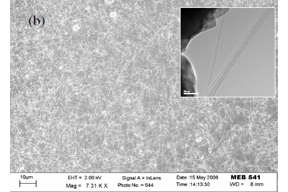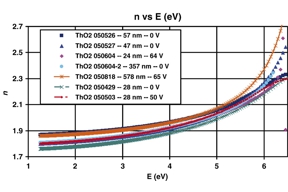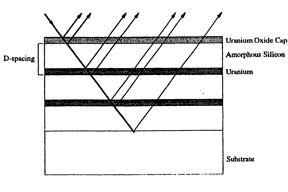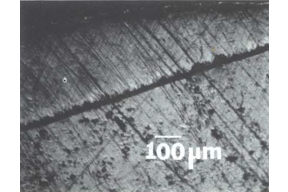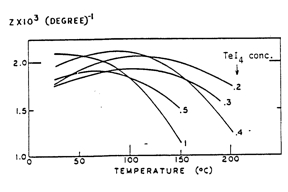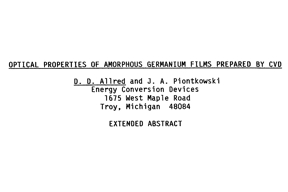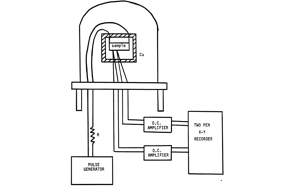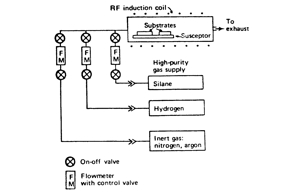2025
-
J. Vac. Sci. Technol. A 43 (6), 060404 (2025).
-
J. Astron. Telesc. Instrum. Syst. 11 (4), 042209 (2025).
-
Space Systems Contamination: Prediction, Control, and Performance 2025, (San Diego, CA, August 2025). Proc. SPIE 13628, 1362802 (2025).
-
Space Systems Contamination: Prediction, Control, and Performance 2025, (San Diego, CA, August 2025). Proc. SPIE 13628, 136280N (2025).
-
Space Systems Contamination: Prediction, Control, and Performance 2025, (San Diego, CA, August 2025). Proc. SPIE 13623, 1362308 (2025).
-
Rev. Sci. Instrum. 96 (8), 083706 (2025).
-
J. Vac. Sci. Technol. A 43 (4), 043408 (2025).
-
Am. J. Phys. 93 (5), 415-421 (2025).
2024
-
SPIE Astronomical Telescopes and Instrumentation, (Yokohama, Japan, August 2024) Proc. SPIE 13100, 131000K (2024).
-
Proc. SPIE 13093, 1309340 (2024).
-
Solar Phys. 272, 112902 (2024).
-
J. Vac. Sci. Technol. B 42 (4), 043001 (2024).
-
J. Vac. Sci. Technol. A 42 (4), 043004 (2024).
2023
-
SPIE Optical Engineering and Applications, (San Diego, CA, October 2023). Proc. SPIE 12694, 1269404 (2023).
-
SPIE Optical Engineering and Applications, (San Diego, CA, 2023). Proc. SPIE 12666, 1266609 (2023).
2022
-
J. Appl. Polym. Sci., e53305 (2022).
-
UV and Higher Energy Photonics: From Materials to Applications 2022 (San Diego, CA, October 2022). Proc. SPIE 1220102, 1220102 (2022).
-
SPIE Astronomical Telescopes + Instrumentation, 2022, (Montréal, Québec, Canada, August 2022). Proc. SPIE 12181, 121813A (2022).
-
SPIE Astronomical Telescopes + Instrumentation, 2022, (Montréal, Québec, Canada, August 2022). Proc. SPIE 12188, 121884M (2022).
2021
-
Chapter 6 in Understanding the Space Environment through Global Measurements, (Elsevier, 2022).
-
OSA Continuum 4 (3), 879-895 (2021).
2020
-
Advances in Optical and Mechanical Technologies for Telescopes and Instrumentation IV, (Online, December 2020). Proc. SPIE 11451, (2020).
-
Advances in Optical and Mechanical Technologies for Telescopes and Instrumentation IV, (Online, December 2020). Proc. SPIE 11451, 788-800 (2020).
-
Advances in X-Ray/EUV Optics and Components XV, (August 2020). Proc. SPIE 11491, 1149104-1 (2020).
-
J. Nucl. Mater. 539, 152356 (2020).
-
Proceedings of the ASME 2019, International Mechanical Engineering Congress and Exposition, IMECE2019 (Salt Lake City, UT, November 2019).
2019
-
Opt. Mater. Express 9 (12), 4677-4687 (2019).
-
Astronomical Optics: Design, Manufacture, and Test of Space and Ground Systems II, 111160O (San Diego, CA, September 2019). Proc. SPIE 11116, (2019).
-
Society of Vacuum Coaters, 2019 Technical Conference Proceedings, Optical Coatings (August 22, 2019).
-
Expanding the Far UV Range of Aluminum-Coated Mirrors for Space-Based Observations to Reflect Hydrogen Lyman Lines via Fluoride MultilayersOptical Interference Coatings 2019, (Santa Ana Pueblo, NM, June 2019).
-
Opt. Express 27 (3), 3324-3336 (2019).
-
2018 Conference on Laboratory Instruction Beyond the First Year of College, Part of the BFY Conference series, (Baltimore, MD, July, 2018).
2018
-
Annual Conference of the Utah Academy of Sciences, Arts, & Letters (Orem, UT, April 2017). J. Utah Acad. Sci. 94, 317-325 (2018).
2017
-
UV/Optical/IR Space Telescopes and Instruments: Innovative Technologies and Concepts VIII Proc. SPIE 10398, 34-01 (2017).
-
J. Nucl. Mater. 487, 288-296 (2017).
-
J. Quant. Spectrosc. Radiat. Transf. 187, 358-363 (2017).
2015
-
J. Microelectromech. Syst. 24 (5), 1331-1337 (2015).
2013
-
J. Phys. Chem. C 117 (32), 16540-16551 (2013).
2012
-
Anal. Chem. 84 (23), 10380-10387 (2012).
-
J. Micromech. Microeng. 22 (5), 055004 (2012).
-
J. Utah Acad. Sci. 88, 444-454 (2012).
2011
-
J. Utah Acad. Sci. 87, 255-265 (2011).
-
J. Vac. Sci. Technol. A 29, 021017 (2011).
2010
-
Thin Solid Films 518 (17), 5014-5017 (2010).
-
Appl. Optics 49 (9), 1581-1585 (2010).
2009
-
Opt. Express 17 (26), 23873-23879 (2009).
-
J. Utah Acad. Sci. 86, 273-286 (2009).
2008
-
Thin Solid Films 517 (3), 1011-1015 (2008).
-
Society of Vacuum Coaters, 2008 Technical Conference, (April 2008, Chicago, IL), 448-442 (2008).
-
Society of Vacuum Coaters, 2008 Technical Conference, (April 2008, Chicago, IL), 448-442 (2008).
-
Rev. Sci. Instrum. 79 (10), 103108 (2008).
-
J. Utah Acad. Sci. 85, 203-211 (2008).
2007
-
J. Utah Acad. Sci. 84, 130-140 (2007).
-
Bounds and Conditions, A Kolob In Our Solar SystemSunstone, (2007).
-
2006 Materials Research Society Fall Meeting, (November 2006, Boston, MA). MRS Proc. 963, 0893-JJ05-09 (2007).
2006
-
Thin Solid Films 515 (3), 847-853 (2006).
-
Society of Vacuum Coaters, 2006 Technical Conference Proceedings, Optical Coating (April 2006, Washington, DC). Proc. SVC 2006, 314-325 (2006).
-
Proc. SPIE 6317, 631711 (2006).
-
Advances in X-Ray/EUV Optics, Components, and Applications, (August 2006, San Diego, CA). Proc. SPIE 6317, 631711 (2006).
-
SpaceOps 2006 Conference, (June 2006, Rome, Italy)
-
J. Non-Cryst. Solids 352 (9-20), 1272-1274 (2006).
-
2005 Materials Research Society Fall Meeting, Symposium JJ – Actinides 2005 – Basic Science, Applications and Technology, (November 2005, Boston, MA). MRS Proc. 893, 207-214 (2006).
2005
-
Summer 2005 SVC Bulletin, 34-38 (2005).
-
Determining Composition of Thin Films of Uranium Oxide by X-Ray Photoelectron SpectroscopyJ. Utah Acad. Sci. 82, 176-186 (2005).
2004
-
Proc. SPIE 5538, 84-91 (2004).
-
Proc. SPIE 5538, 84-91 (2004).
-
AIP Conf. Proc. 705, 796-799 (2004).
-
47th Annual Technical Conference Proceedings, (Dallas, TX, April 2004), Vol. 47, (Society of Vacuum Coaters, Albuquerque, NM, 2004) 368-376.
-
Proc. SPIE 5193, 191-203 (2004).
2003
-
What the Universe Means to People Like MeDialogue 36, 110-125 (2003).
2002
-
Proc. SPIE 4782, 212-223 (2002).
-
Mars JarsFifth International Mars Society Conference, (August 2002, Boulder, CO).
-
The Optical Constants of Sputtered U and a Si at 30.4 and 58.4 nmJ. Utah Acad. Sci. 76, 74-87 (2002).
2001
-
J. X-ray Sci. Technol. 9, 1-11 (2001).
2000
-
Space Sci. Rev. 91 (1-2), 197-242 (2000).
1999
-
Proc. SPIE 3767, 280-287 (1999).
-
Proc. SPIE 3767, 288-294 (1999).
-
Thin Solid Films 338 (1-2), 100-104 (1999).
1997
-
J. X-ray Sci. Technol. 7 (2), 159-170 (1997).
1996
-
Phys. Rev. B 54 (6), R3679-R3682 (1996).
-
J. X-ray Sci. Technol. 6 (1), 1-31 (1996).
-
Hyperfine Interact. 102, 695-698 (1996).
1995
-
J. Raman Spectrosc. 26 (12), 1039-1043 (1995).
-
Phys. Rev. A 52 (6), 4631-4639 (1995).
-
J. Vac. Sci. Technol. A 13 (1), 136 (1995).
1994
-
J. Vac. Sci. Technol. A 12 (4), 2581 (1994).
-
J. Vac. Sci. Technol. A 12 (4), 1535 (1994).
-
J. Vac. Sci. Technol. A 12 (4), 2565 (1994).
1993
-
24th Annual Boulder Damage Symposium Proceedings -- Laser-Induced Damage in Optical Materials, (September 1992, Boulder, CO). Proc. SPIE 1848, 521 (1993).
-
Nanostruct. Mat. 3 (1-6), 419-424 (1993).
-
Phys. Rev. B 47 (20), 13363-13369 (1993).
-
Phys. Rev. B 47 (10), 6119-6121 (1993).
1992
-
Thin Solid Films 220 (1-2), 284-288 (1992).
-
J. X-ray Sci. Technol. 3 (3), 222-228 (1992).
-
Multilayer and Grazing Incidence X-Ray/EUV Optics for Astronomy and Projection Lithography, (July 1992, San Diego, CA). Proc. SPIE 1742, 476 (1992).
-
Soft X-Ray Microscopy, (July 1992, San Diego, CA). Proc. SPIE 1741, 12-18 (1992).
-
Manufacturing of atomically sharp silicon tips and their use as photocathodesJ. Utah Acad. Sci. 69, 257-272 (1992).
-
J. Vac. Sci. Technol. A 10 (1), 145-151 (1992).
1991
-
EUV, X-Ray, and Gamma-Ray Instrumentation for Astronomy II, (July 1991, San Diego, CA). Proc. SPIE 1549, 147-154 (1991).
-
Optical Surfaces Resistant to Severe Environments, (July 1991, San Diego, CA). Proc. SPIE 1330, 164-167 (1991).
-
Solid State Commun. 79 (3), 205-207 (1991).
-
J. Vac. Sci. Technol. A 9 (3), 550-554 (1991).
1990
-
Proc. SPIE 1331, 170-178 (1990).
-
J. Vac. Sci. Technol. A 8 (4), 3255-3259 (1990).
-
J. Vac. Sci. Technol. A 8 (3), 1934-1938 (1990).
-
Materials Research Society
-
Materials Research Society
-
Materials Research Society
1989
-
X-Ray/EUV Optics for Astronomy and Microscopy, (July 1989, San Diego, CA). Proc. SPIE 1160, 56-65 (1989).
-
Proc. SPIE 1160, 229-234 (1989).
-
Proc. SPIE 1159, 664 (1989).
1988
-
Accelerated Life Test for Thermoelectric Junctions: Solder Element InteractionsProceedings of the Seventh International Conference on Thermoelectric Energy Conversion
1987
-
Phys. Rev. Lett. 58 (24), 2579-2581 (1987).
-
Materials Research Society
1986
-
Proc. SPIE 0821, 167-173 (1986).
-
A New Multiphase Thermoelectric Material for Power GenerationSixth Internional Conference on Thermoelectric Energy Conversion, (March 1986, Arlington, TX).
-
J. Mat. Res. 1, 468-475 (1986).
1985
-
Sol. Energ. Mater. 12 (2), 87-129 (1985).
1984
-
Optical Properties of Amorphous Germanium Films Prepared by CVDFifth International Conference on Thermoelectric Energy Conversion, (March 1984, Arlington, TX), 546-557 (1984).
-
Thermal Diffusivity by Modified Angstrom TechniqueFifth International Conference on Thermoelectric Energy Conversion, (March 1984, Arlington, TX), p 116-119 (1984).
1983
-
CVD a-Ge and a-Ge:X Films: Preparation and PropertiesFourth European Conference on Chemical Vapour Deposition
1981
-
Thin Solid Films 83 (4), 393-398 (1981).
-
IEEE Trans. Nucl. Sci. 28 (2), 1838-1840 (1981).
1980
-
J. Non-Cryst. Solids 35-36 (1), 213-218 (1980).
1979
-
Sol. Energ. Mater. 2 (1), 107-124 (1979).
-
Selective Surfaces by Chemical Vapor DepositionSecond Annual Coating for Solar Collectors Symposium
-
Sol. Energ. Mater. 1, 11-27 (1979).
1978
-
Proc. SPIE 0161, 66-71 (1978).
-
Proc. SPIE 0161, 72-77 (1978).
-
Nucl. Instr. Meth. 149 (1-3), 9-18 (1978).
-
Nucl. Instr. Meth. 149 (1-3), 19-39 (1978).
-
Phys. Chem. Miner. 3 (2), 199-211 (1978).
1977
-
Appl. Phys. Lett. 31, 582-585 (1977).
1972
-
Phys. Rev. C 6 (1), 373-375 (1972).
‡Undergraduate Student Author
†Graduate Student Author
Selected Publications
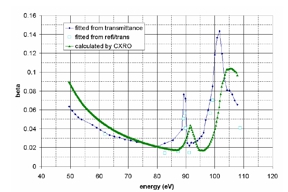
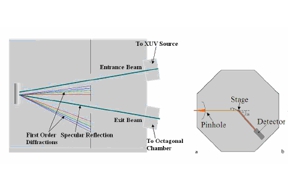
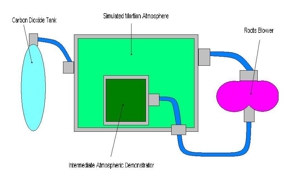
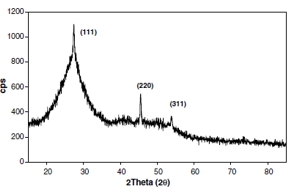
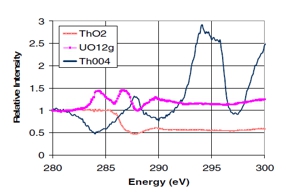


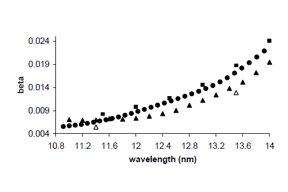
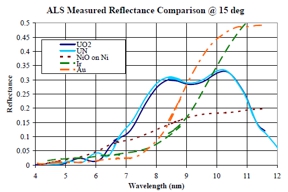
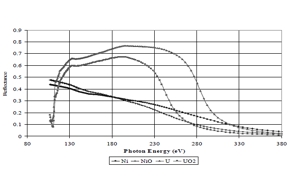
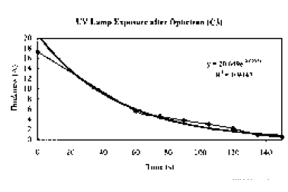
The extreme ultraviolet (EUV) is becoming increasingly important. Principal applications include orbital space-based astronomy and lithography for integrated circuit computer chips. A main impediment to further development of efficient mirrors is the lack of reliable optical constants for various materials in this region of the electromagnetic spectrum. One reason for the unreliability of the optical constants is that the sample surfaces are often contaminated with foreign material, especially organic compounds, when exposed to laboratory air. Several cleaning techniques were evaluated, namely: 1) strippable solid optical cleaner (Opticlean®); 2) oxygen plasma etch; 3) high energy UV light/ozone; 4) strippable coating followed by oxygen plasma etch, 5) strippable coating followed by high intensity UV light and, 6) exposure to cold pressurized carbon dioxide (CO2 snow). These processes are compared experimentally based on effectiveness, cleaning time and ease of use. DADMAC (polydiallyldimethyl-ammonium chloride), which forms a layer of known, uniform thickness on silicon wafers is used as a “stand in” for organic contamination. Effectiveness is judged on how well the surface is cleaned. Ellipsometry is used to determine the thicknesses of surface layers. XPS (X-ray Photoelectron Spectroscopy) is used to look for trace contaminants, particularly carbon from the DADMAC. We find that the strippable cleaning coat leaves a residue. Oxygen plasma rapidly removes contaminants, but can quickly oxidize the silicon surface. Exposure to the UV light/ozone for five minutes leaves the surface clean with little additional oxidation. Oxygen plasma or UV light effectively removes the strippable coat residue. Exposure to cold pressurized carbon dioxide has reduced oxide level in one case. The recommended procedure for cleaning bare silicon wafers is strippable coat application followed by 2.5 minutes of exposure to high intensity UV light.
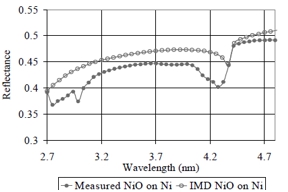
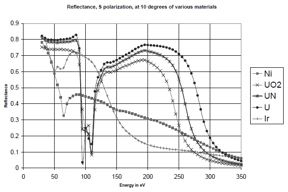
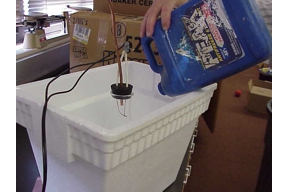
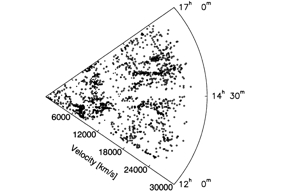
We designed multilayer mirrors for the IMAGE/Explorer mission that were intended to reflect well at 304 * and poorly at 584 *. The best designs utilized the novel materials U and Y_2O_3with Al or Si as spacer layers. The highest design reflectivities were obtained with aperiodic multilayers, although these were too hard to grow in practice. We found these novel designs using a genetic algorithm calling on a database of 43 promising materials with the freedom of aperiodic multilayer stacks.
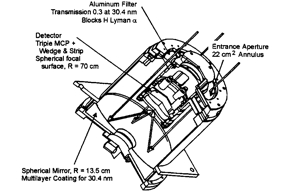
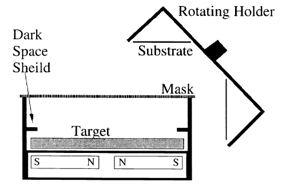

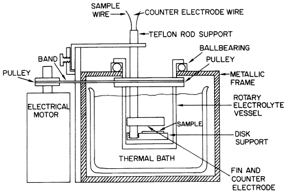
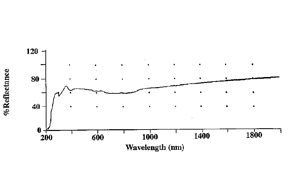
We report the preparation and structural characterization of lithium hydride and lithium fluoride thin films. These materials, due to their low absorption in the soft x-ray range, may have a role as spacer layers in multilayer mirrors. Theoretical reflection calculations suggest that an epitaxial crystalline multilayer stack of a nitride and a lithium compound spacer layer could produce respectable reflectance for short soft x-ray wavelengths (λ < 10 nm). Lithium targets were magnetron sputtered in the presence of hydrogen or ammonia to prepare the LiH films and nitrogen trifluoride to prepare the LiF films. The films were deposited on room temperature Si (100) or MgO (100) substrates. A near IR-Visible-UV spectrometer indicated a drop in reflectance at ~250 nm for a 100-nm-thick LiH film. This corresponds to a 5-eV band gap (characteristic of LiH). UV fluorescence indicated characteristic LiH defect bands at 2.5, 3.5, and 4.4 eV. The UV fluorescence characterization also indicated a possible lithium oxide (Li2O) contamination peak at 3.1 eV in some of our thin films. Film surface morphology, examined by scanning electron microscopy, appeared extremely rough. The roughness size varied with reactive gas pressure and the type of substrate surface. A LiH/MoN multilayer was constructed, but no significant d spacing peak was seen in a low angle CuKα XRD scan. It is believed that the roughness of the LiH film prevented smooth, uniform planar growth of the multilayer stack. Possible reasons of rough growth are briefly discussed.
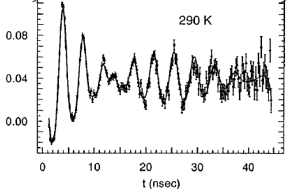
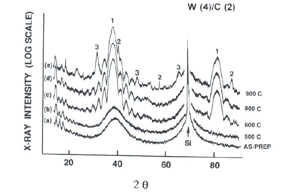
We report the effect that thermal annealing in inert and oxidizing atmospheres, and with and without encapsulating layers, has on the structure of tungsten/carbon [W/C] multilayer thin films. This study focuses on the tungsten component and deals mainly with multilayers where the ratio of thickness of tungsten layers is equal to or greater than for the carbon layers (that is, γ ≤ 0.5). This is in contrast to prior studies where the tungsten layer thickness was generally held constant and the carbon layer was varied. Thermal annealing in inert atmospheres produces reactions and other structural changes in the tungsten and carbide layers which depend on the as-deposited multilayer structure which depends, in turn, on the thickness of the tungsten layer. In samples where both the tungsten and carbide fractions of the multilayer are completely amorphous as deposited, which is the case for thin tungsten layers (thickness of tungsten (tw) < 4 nm/period), the reactions in the tungsten layer forming crystalline tungsten and tungsten carbide occur at annealing temperatures above 900°C. The layer pair spacing, or period, (d), in this group shows an expansion of up to 10–15% of the original value as has been reported in the past. Changes in both the tungsten and carbide layers, and their interfaces, contribute to changes in d spacing and relative thickness of the high and low Z components. When the tungsten layer thickness exceeds 4 nm per period the tungsten is partially crystallized in as-prepared samples. In such multilayers interfacial reactions, producing an oriented partially crystalline W2C/C superlattice, occur at temperatures of 600°C and below. The fact that W2C crystallites in one period can form a structure which is correlated to W2C crystallites in neighboring layers is somewhat surprising, since layers are presumably still separated by amorphous carbon which is still visible via Raman. The expansion of the layer pair spacing is relatively small (<5%) in this group and, more importantly, mostly involves increases in the thickness of the high Z components. Samples annealed in air at temperatures below 300°C are progressively destroyed by the oxidation of both tungsten and carbide layers. Encapsulation of similar multilayers with a thin (30 nm) dielectric layer of any of several types can retard oxidation to 600°C. The silicon-containing encapsulants generally perform better. Failure at this temperature is seen to occur from pinhole formation.
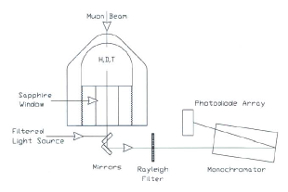
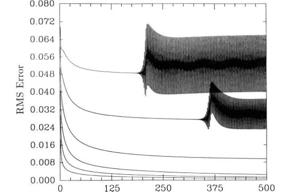
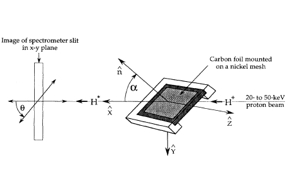

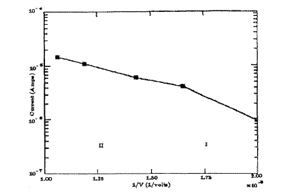
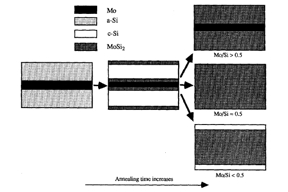

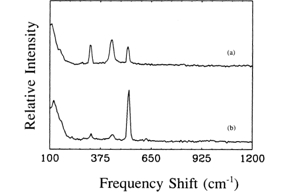
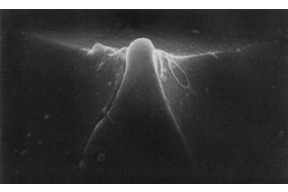
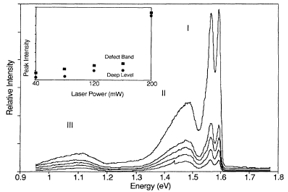


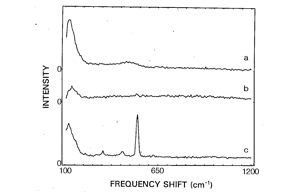
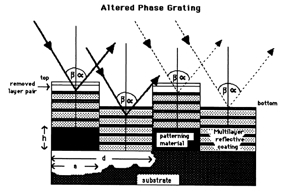
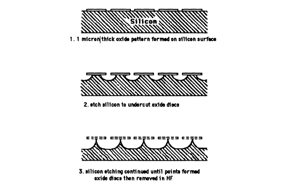
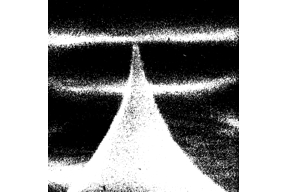

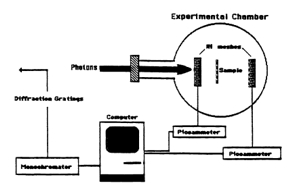
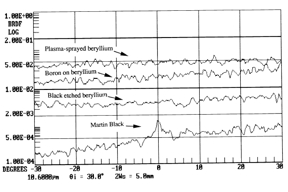
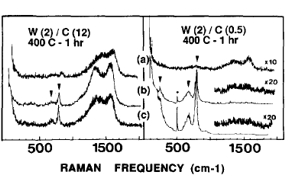
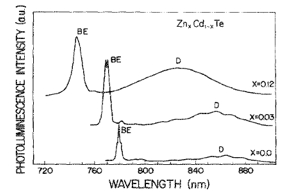
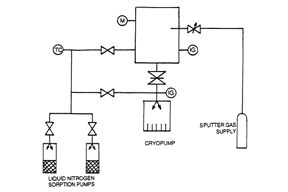
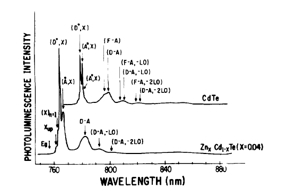
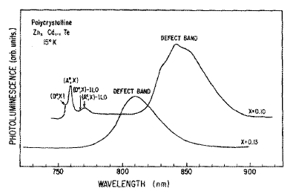
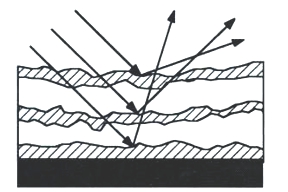
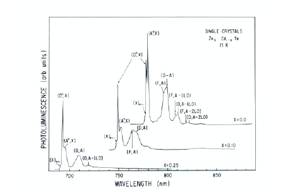
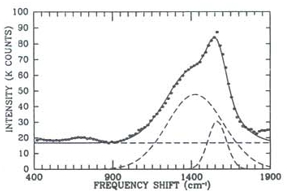
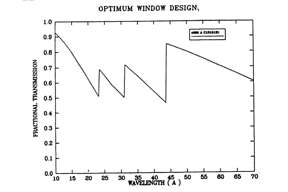
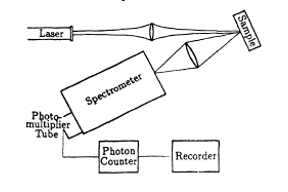
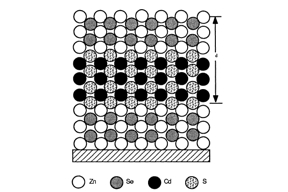
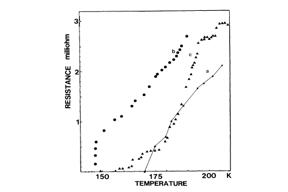
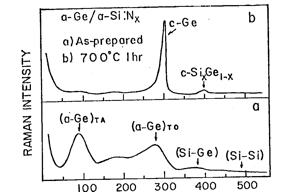
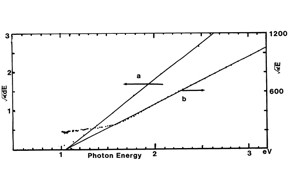
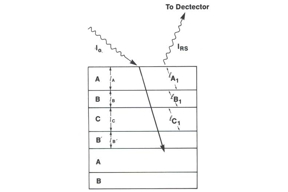
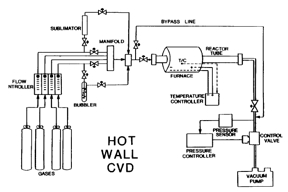
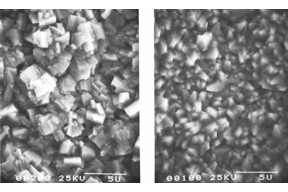
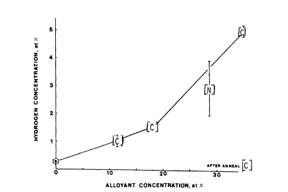
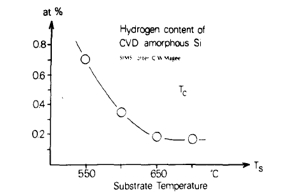
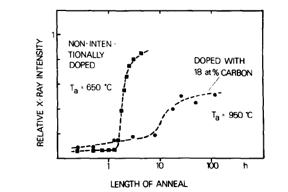
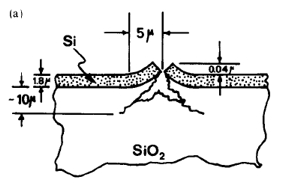
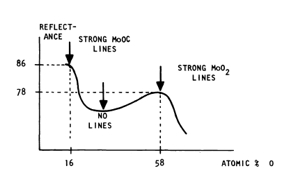
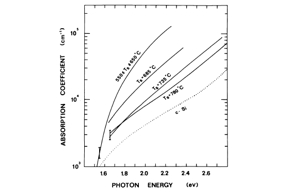
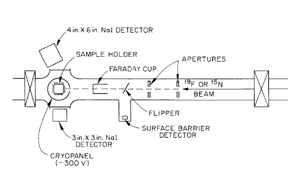
The application of nuclear reaction techniques to hydrogen analysis problems in metallurgical, mineralogical and semiconductor areas is described. Hydrogen analyses and profiles obtained with both the 1H(19F, αγ)16O and 1H(15N, αγ)12C reactions are presented. The advantages and disadvantages of the two techniques are discussed. Particular emphasis will be given to interpretive problems associated with analyzing the data. Various corrections to the data will be discussed, including off-resonance cross-section corrections and lower energy resonance corrections. Both crystalline and amorphous materials are examined. The hydrogen content of electrodeposited hard gold films has been determined as a function of plating conditions. Hydrogen contents as high as 9 atom % have been measured. The hydrogen profile of natural and synthetic SiO2 samples was determined. Hydrogen was found to be quite stable in amorphous silica samples but highly mobile in crystalline quartz samples under the analysis conditions. A hydrogen depth profile for a film of glow discharge deposited amorphous silicon (∼4500 Å thick) has been obtained and will be compared with a profile measured by secondary ion mass spectrometry (SIMS) on the same sample.
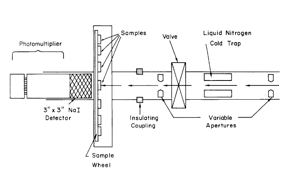
Over the last few years many ion beam techniques have been reported for the profiling of hydrogen in materials. We have evaluated nine of these using similar samples of hydrogen ion-implanted into silicon. When possible the samples were analysed using two or more techniques to confirm the ion-implanted accuracy. We report the results of this work which has produced a consensus profile of H in silicon which is useful as a calibration standard. The analytical techniques used have capabilities ranging from very high depth resolution (≈50Å) and high sensitivity (< 1 ppm) to deep probes for hydrogen which can sample throughout thin sheets (up to 0.2 mm thick).

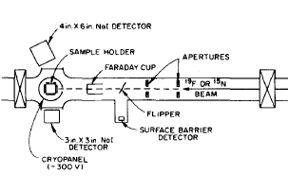
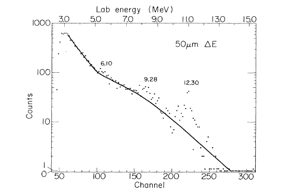

Particulate contamination requires dust mitigation techniques to provide low-scatter surfaces on sensitive instrumentation in space. We have shown that poly(olefin sulfone)s photodegrade under spacelike conditions: in vacuum and with UV light exposure. We now demonstrate that photodegradable polymers can reduce dust accumulation on optical surfaces for space applications. This investigation shows that the dissociative degradation of poly(olefin sulfone)s significantly decreased the number of dust particles on a dust-coated surface. These results suggest a powerful way to mitigate the collection of extraterrestrial dust on optical surfaces in space, enabling passive removal of particulate contamination without any direct human intervention.

We describe efforts to develop broadband mirror coatings with high performance that will extend from the far-ultraviolet (FUV) to infrared wavelengths. Our team at the Goddard Space Flight Center has developed a reactive physical vapor deposition (rPVD) process that combines a fluorination with a XeF2 gas (which grants a thin AlF3 layer) in between the Al and the metal-fluoride protection layer (either LiF or MgF2) that are done with the conventional PVD process. This recently developed rPVD process produces protected Al mirrors coatings with an improved average FUV reflectance between 10% and 15% higher (when compared with conventionally prepared samples). We have termed these coatings as XeLiF when the dielectric overcoat is LiF or XeMgF2 when the dielectric overcoat is MgF2. The XeLiF-coated Al mirrors meet current goals for advanced broadband mirrors in the FUV (R>70% at 103 nm and R>80 above 110 nm), whereas the XeMgF2 provides R>80% above 115 nm. The IR/Vis/UV reflectance for either XeLiF or XeMgF2 mirrors is similar to the theoretical reflectance of bare aluminum at wavelengths >200 nm. In addition, long-term lifetime testings of XeLiF mirrors indicate the rPVD process produces more environmentally stable coatings, where a XeLiF sample showed a degradation in the average FUV reflectance of around 1% to 2% when stored in a relative humidity of 40% over a period of 3.5 years. These results are a remarkable improvement when compared with conventionally prepared Al+LiF samples that would degrade their FUV reflectance in a matter of weeks or months when exposed to those kinds of relative humidity levels. Surface topographies on several XeLiF samples with varying Al and LiF thicknesses have been measured with an atomic force microscope (AFM). The root mean square (RMS) roughness (σ) values derived from these AFM results have ranged between 0.6 and 0.9 nm. For comparison, samples without the Xe process start off by having an RMS roughness that is 30% larger than samples treated with the XeF2 gas. We have also determined that these roughness values are showing a slight increase, ranging between 0.9 and 1.0 nm, when samples are exposed to room temperature and relative humidity as high as 50% over one week. Both of these key performance parameters (environmental stability in reflectance and smoothness of ≤1 nm) are key considerations for using the XeLiF coating in the primary and secondary mirrors of the Habitable Worlds Observatory (HWO). We also show evidence that the rPVD coating process is compatible with deposition on Si-based gratings. It is known that XeF2 vapor is a strong Si etchant, thus the demonstration that the native SiO2 layer on Si test samples is sufficient to protect the groove profile of E-beam-ruled Si gratings from degradation is an important and significant finding.

Starshade technology represents a promising approach for direct exoplanet imaging, offering stellar light suppression up to a factor of 1010. Particulate contamination that clings to the edge of the starshade causes solar glint which could compromise Earth-like exoplanet detection. In previous research, when testing at atmospheric pressure, McKeithen et al. 2023 observed that the sharp edge have fewer particles larger than 14 microns, and more particles smaller than 14 microns, than expected from the surface distribution. To determine if this observation was reproducible in different environments, we contaminated Starshade edge coupons in low vacuum conditions. We characterized the surface and edge cleanliness level using optical microscopy, a custom ImageJ macro and R program that calculated the counts and area of particles in each image. We then compared our results with McKeithen et al. confirming their result, but the crossover occurred at particle diameters of about 3 microns rather than 14 microns. In our work, we propose different mechanisms which could affect any differences between the vacuum environment tests and the tests performed in air previously.

Xenon difluoride passivated aluminum with a lithium fluoride overcoat (Al+XeLiF) mirror coatings are promising candidates for future space telescope missions due to their high reflectance down to 100nm. The XeLiF mirror coating blocks aluminum oxidation. Aluminum oxide is undesirable since it significantly reduces the far UV (100-to-190nm) reflectance. Cleaning techniques for this ideal coating require the balance of traditional surface cleaning with careful handling of the hygroscopic LiF. Photonic Cleaning Technologies’ First Contact Polymers (FCP) are proven to clean and protect optical surfaces effectively. A specialized FCP formulation may be required for Al+XeLiF. We monitored Al+XeLiF changes under repeated application of four FCP formulations using variable angle spectroscopic ellipsometry (VASE), reflectance, and Atomic Force Microscopy (AFM). We also applied multiple FCP formulations to both Al+XeLiF and Al+LiF samples and stored them in different humidity environments to monitor potential protective qualities of each formulation. We observed that two FCP formulations can effectively protect Al+XeLiF in 40% RH without Al loss over half a year.

Magnesium fluoride on xenon difluoride passivated aluminum (Al+XeMgF2) mirrors have high reflectance encompassing the H Lyman-α at 121.6 nm. Al+XeMgF2 is a key candidate for space telescopes and satellites that demand far-UV (FUV) measurements coupled with high reflectance at longer wavelengths. Contamination can significantly reduce FUV reflectance, so Al+XeMgF2 mirrors must be as clean as possible. Protecting the surfaces while in storage is also desirable. We investigated the suitability of four different formulations of Photonic Cleaning Technologies' First Contact Polymer for cleaning and protecting Al+XeMgF2 coatings by repeatedly cleaning test samples. These were cleaved from a silicon wafer coated with 300 nm of chemical vapor deposited (CVD) silicon nitride (Si3N4). All the formulations could clean samples at least once. Using Variable-Angle, Spectroscopic Ellipsometry (VASE), we determined that two (S2 and S3) of the four tested formulations were able to clean and protect the Al+XeMgF2 surfaces multiple times (>20) over 5 months without detectable alumina growth on the Al in a low humidity environment. There were also no changes to the thickness of 'apparent' MgF2. Apparent MgF2 includes the deposited MgF2, the 2–3 nm AlF3 layer produced by the XeF2 passivation step, and contributions from surface roughening. There was also no detectable alumina growth for the controls. The fact that the samples were stored between tests in a desiccator with their First Contact overcoat provides evidence that Al+XeMgF2 samples can successfully be protected and stored under some First Contact formulations for at least five months in a dry environment. Far-ultraviolet reflectance is not reported here.

Extreme-ultraviolet light has become more important for advancements in modern computer chip manufacturing, and as such, there needs to be more access to extreme-ultraviolet sources for observing properties of novel technology materials. Some of these extreme-ultraviolet sources need to have the ability to tune the polarization for observing dichroic properties of materials such as magnetism. We present a compact extreme-ultraviolet tabletop source, based on high harmonic generation, designed for use in polarization-sensitive imaging. The source is able to generate circularly polarized harmonics using the MAch-ZEhnder-Less for Threefold Optical Virginia spiderwort apparatus. The linearly polarized 42 and 52 eV beams have been optimized, achieving an average power of 19.4 and 8.0 nW, respectively. Using the 42 eV linearly polarized beam for ptychography, we have imaged a Siemens star test resolution target and obtained a resolution of 160 nm.

The far-UV (FUV) reflectance of the state-of-the-art, broadband UV/optical/IR mirrors of XeF2-passivated LiF on Al (Al + XeLiF) is promising for future space telescope missions. To reach their potential, dependable cleaning procedures and storage methods for such reflective surfaces need to be developed. First Contact™ polymer (FCP) formulations have proven to be a reliable method for cleaning conventional mirror surfaces coated with oxides or bare metal and for protecting them in storage. We report here on studies of the cleaning and storage of Al + XeLiF samples using customized FCP formulations designed by Photonic Cleaning Technologies. Cleaning of such mirrors is demanding since fluoride coatings are softer than oxides and can be moisture sensitive. Any damage that marks the overcoat can lead to catastrophic loss of FUV reflectance due to surface roughening and formation of aluminum oxide, which is FUV opaque. We discovered that one formulation could be successfully applied to and removed from Al + XeLiF coatings multiple times. The coatings retained low roughness, minimal aluminum oxide thickness, and high far-UV reflectance. Another of the four FCP formulations successfully cleaned the Al + XeLiF coatings several times. Variable-angle, spectroscopic ellipsometry, tapping-mode atomic force microscopy, x-ray photoelectron spectroscopy, and FUV reflectance allowed us to observe any changes in reflectance and surface roughness, the formation of aluminum oxide, and damage to coating integrity. From the studies of the range of FCP-fluoride interactions, we noted that too much polymer-to-surface adhesion or exposure to trace water in the polymer can result in coating damage.

We present an undergraduate optics instructional laboratory designed to teach skills relevant to a broad range of modern scientific and technical careers. In this laboratory project, students image a custom aperture using coherent diffraction imaging, while learning principles and skills related to digital image processing and computational imaging, including multidimensional Fourier analysis, iterative phase retrieval, noise reduction, finite dynamic range, and sampling considerations. After briefly reviewing these imaging principles, we describe the required experimental materials and setup for this project. Our experimental apparatus is both inexpensive and portable, and a software application we developed for interactive data analysis is freely available.

A new deposition method developed by Goddard Space Flight Center fluorinates Al mirrors with XeF2 followed by a LiF coating to create what they term Al+XeLiF. This in-situ, room temperature process produces mirrors with high reflectivity in a broad spectral range, from the FUV to the IR, and is reported to be stable in relative humidities of 30% and lower. These mirrors are envisioned for missions requiring sensitivity down to 100 nm wavelength such as the habitable worlds observatory. Because most mission integration and testing campaigns require prolonged exposure to lab environments, and launch sites experience high relative humidities (RH) on average, some at 80% RH. We investigate Al+XeLiF stability in a wider range of temperatures and humidities along with employing additional characterization techniques including atomic force microscopy and x-ray photoelectron spectroscopy. We found that Al+XeLiF is stable in environments up to 82%RH when kept at cooler temperatures (3°C and 21°C). However, this material is unstable when stored at 60°C, experiencing roughening and loss in reflection from resulting Al surface plasmon excitation.

Astronomical instrumentation for measurements in the Far Ultraviolet (FUV, 90−200 nm) have historically considered aluminum (Al) thin film mirrors due to this material high reflectance over this wavelength range. However, the native aluminum oxide layer that forms on Al upon exposure to the atmosphere is strongly absorbing in this wavelength range, requiring that the films be protected with a dielectric that inhibits oxidation. Typically, magnesium fluoride (MgF2) or lithium fluoride (LiF) coatings are used as protective layers, but each has shortcomings. For example, MgF2 has an absorption cutoff at 115 nm that reduces performance below this wavelength, which is a critical part of the FUV spectrum for observational astrophysics. The use of LiF as a protection for Al provides a lower absorption cutoff at 100 nm, but it is hygroscopic and thus susceptible to degradation in humid conditions. Our team at GSFC has developed a new reactive Physical Vapor Deposition (rPVD) process that consists of a fluorination process with XeF2 gas combined with our traditional PVD process. We have found that this new rPVD process produces Al+XeF2+LiF (XeLiF) and Al+XeF2+MgF2 (XeMgF2) mirror coatings with unprecedented reflectance. In addition, the rPVD process seems to produce much more environmentally stable coatings (when compared to the conventional process without the XeF2 fluorination). We report on IR/Vis/UV reflectance of XeLiF and XeMgF2 mirrors. The surface roughness as well as the FUV reflectance measured over a period of 8 months for a XeLiF sample with a relatively thin (≃ 30 nm) Al layer are also reported. We have also been investigating the compatibility of this rPVD coating process for potential efficiency enhancements of Si-based gratings. Since it is known that the XeF2 vapor is a strong Si etchant, we are investigating if the native SiO2 layer on Si is sufficient to protect the groove profile of E-beam-ruled Si gratings from degradation. Preliminary results indicate that the native SiO2 layer is an effective barrier against etching of Si by XeF2.

The ubiquity of particulate contamination requires dust mitigation techniques to provide low scatter surfaces and edges on sensitive optical devices in space. Poly(olefin sulfone)s have been shown to photodegrade with the assistance of a photobase generator when exposed to UV light (254 nm) and heat (120 °C). These may be applicable in minimizing dust on optical surfaces for space applications. However, their behavior in vacuum has not been fully characterized. We synthesized poly(2-methyl-1-pentene sulfone) (PMPS) and poly(1-hexene sulfone) (PHS) with and without a photobase generator. We studied the photodegradation (172 nm or 254 nm) of thin films in vacuum. Spectroscopic ellipsometry was used to quantify film thickness over time. The PMPS and PHS films both degraded when exposed to UV light in vacuum, though PHS to a lesser degree. We found that heat was not required to cause degradation, and that degradation occurred with UV irradiation even without a photobase generator. This investigation shows that poly(olefin sulfone)s could be used to protect optical surfaces until their deployment in space.

Windows for vacuum ultraviolet (VUV) sources are valuable for many applications but difficult to fabricate due to most materials being too absorptive at VUV wavelengths. We have designed, fabricated, and characterized a carbon nanotube (CNT) collimator as a window with high (VUV) transmission and significant differential pumping. The CNT collimators are arrays of square channels of various dimensions and height with sidewalls composed of vertically aligned CNT forests. The CNT collimators in this work exhibited peak intensity transmissions for VUV light (58.4 nm) of 18%–37% of that reported for the same system without a collimator present [S. Olsen, D. Allred, and R. Vanfleet, J. Vac. Sci. Technol. A (2024)]. Further analysis found that the peak intensity transmissions were lowered due to carbon deposition on the phosphor viewing screen from contaminants. The CNT collimator also had significant sidewall reflection in the VUV range (R = 0.21 +/- 0.08) in the VUV range for angles 15.6 degrees and below). Pressure ratios (low pressure over high pressure) in the VUV transmission experiment were dominated by leaks in the alignment mechanism. Additional experiments demonstrated the CNT collimator’s reflection and superior differential pumping with pressure ratios less than 0.001.

Hollow cathodes are a common type of vacuum ultraviolet (VUV) light source with a wide range of design and application. We determined the VUV (58.4 nm) intensity distribution of a hollow cathode as a function of current and pressure. Our model describes the intensity distribution of a McPherson 629-like hollow cathode helium plasma within the range of 0.50–1.00 A and 0.50–1.00 Torr as a ring with a center peak. We found that for all pressures and currents considered, the ring emits more VUV light than the center peak. We also found that the center peak has a minimum VUV light emission near 0.9 Torr.
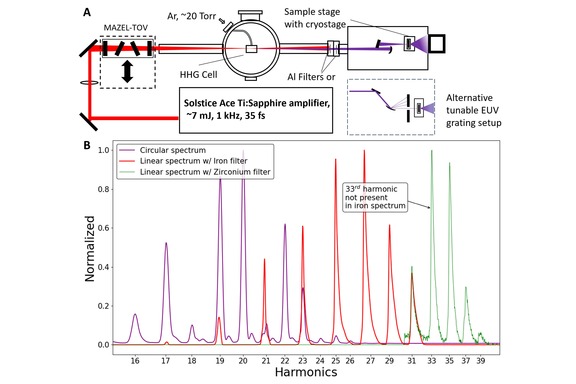
Tabletop extreme ultraviolet (EUV) sources based on high harmonic generation (HHG) have been used as a powerful tool for probing magnetism. Obtaining magnetic information via magneto-optical contrast often requires the energy of the light to be tuned to magnetic resonance energies of the magnetic element present in the material; therefore, it is essential to calibrate the HHG spectrum to well defined absorption energies of materials. We have designed and assembled a HHG based EUV source for studying transition metal magnetic materials at their resonant M-absorption edges (35-75 eV of photon energy). One material of interest is iron, for which the iron M2,3 edge is 52.7 eV (23.5 nm wavelength) according to CXRO. We prepared and characterized a thin sample of iron for absorption spectroscopy and calibration of the absorption edge with beamline 6.3.2 at the Advance Light Source (ALS) in Lawrence Berkeley National Laboratory. This well characterized sample was capped with gold to prevent oxidation. From these measurements we extracted the absorption part of the index of refraction β spectrally and confirmed that the absorption edge of iron is 52.7 eV. With this information, we can better calibrate the HHG spectrum of our tabletop EUV source. Calibration of the HHG spectrum was achieved using model fitting the HHG spectrum using the grating equation and law of cosines while taking account into the results of the ALS data. We have determined that driving wavelength of the HHG process to be 773 nm. We also conclude that the chirp of the driving laser pulse can cause an energy shift to a HHG spectrum.

First Contact (FC) Polymer™, developed by Photonic Cleaning Technologies, is used to clean and protect surfaces from contamination. The polymer creates a peelable coating that renders the surface clean while not leaving visible residues. To investigate the effectiveness of FC at the subnanometer level, we used variable-angle, spectroscopic ellipsometry (VASE) to measure sample top-layer thickness after repeated application/storage/removal cycles of standard (red) FC with three sample sets (CVD Si3N4 on Si, bare Si, and SiO2 on Si). The samples were measured via VASE after every FC removal to understand contaminant thickness changes with “peel-off” count. Control samples were also measured at each iteration. Ellipsometric analysis revealed FC removed, during the first peel-off, impurity from the surface of samples treated with impure isopropyl alcohol. Linear regressions and t-tests comparing samples with and without FC were employed for evaluating changes with peel-off counts. There is evidence for the very slight build-up of material which is not removed by iterative FC application/removal cycles on these samples. It is slight, <0.1 nm after 17 iterations, in the case of native oxide on Si.

One class of neutron detectors for illicit nuclear materials are capture-gated detectors, which use organic scintillators to slow neutrons while emitting fluorescent light and elements that have high neutron capture cross-sections to provide a second signal. Homogeneous detectors composed of neutron capturing metallo-organics within plastic darken due to their chemical instability, while heterogeneous detectors frequently result in non-transparent material due to a mismatch of the refractive index. These detectors are often polymerized through bulk polymerization, but there is little data available on this process applied to mixtures of polystyrene (PS) and polyvinyl toluene (PVT), two commonly used polymers in plastic scintillators. This work presents bulk polymerization processing toward an index-matched, heterogeneous capture-gated neutron detector based on PS and PVT copolymers with a range of refractive indices. Specifically 1:3, 1:1, and 3:1 PS:PVT ratios were manufactured and their refractive indices, measured by refractometry, were compared to a theoretical model based on a mixture of the refractive indices of pure PS and PVT. Finally, a composite of PS/PVT and an Ohara S-BAL42 glass was developed to confirm the index-matching capability of the process as a step toward developing a heterogenous, capture-gated neutron detector with high light transmission efficiencies allowed by index-matched materials.

Hollow cathode plasmas are common extreme ultraviolet (EUV) lamps used for material characterization. However, the relatively high pressure of the plasma can affect downstream instruments, as well as absorb the EUV. EUV windows are difficult to fabricate due to EUV’s strong interaction with all materials. We present a carbon nanotube (CNT) microfabricated window composed of multiple high aspect-ratio columns in parallel. The open areas allow wide bandpass transmission, while the walls restrict gas flow. We model the CNT window transmission as a weight function on the light from of a Mcpherson 629-like hollow cathode helium plasma in visible wavelengths. We model the CNT window differential pumping as a series of columns between two chambers of different pressures.

Four evaporated, thin-film Al samples protected by a thin (29±2 nm) aluminum fluoride (AlF3) overcoat stored in dry (dew point 276K ), 327 K air over a period of 2500 hours exhibited no significant changes in the thickness of the protective AlF3 layer nor growth in aluminum oxide as observed by variable-angled, spectroscopic ellipsometry. Two of the samples had AlF3 evaporated at T>200°C, two without substrate heating. No difference in aging was noted amongst the samples. Since many months may elapse between fabrication and launch of the completed observatory, this result contributes to understanding the boundaries in temperature and humidity separating negligible changes in fluoride-containing optical components from unacceptable degradation. While negligible changes in thicknesses were observed, there were changes in the ellipsometric data, psi and delta, with time. In this study, we also present our use of an effective medium approximation model in understanding changes in the fluoride layer with aging. The observed changes in SE parameters are here interpreted as changes in void fraction, though the presence of some water was not ruled out. Apparent void fraction fell by a factor of two by the end of the 2500 hours. The decreasing void fraction suggests that the films might be becoming more compact with time. Other surface sensitive techniques such as AFM are needed to narrow down possible explanations for observed changes.
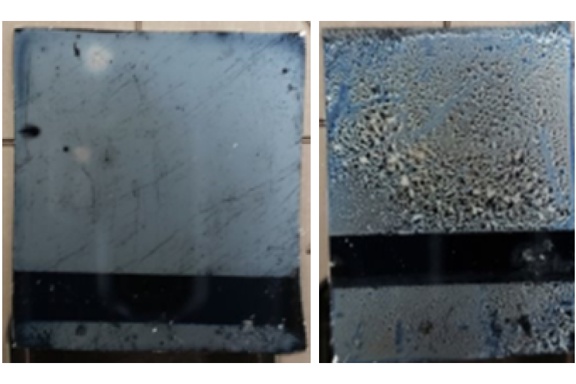
Aluminum mirrors protected by metal fluoride overcoats are crucial for FUV observations. Many contemplated missions specify optics elements with high reflectance down to 103 nm (Lyman beta). Lithium fluoride (LiF) has the highest band gap of any solid material and thus finds applications in FUV optics. However, LiF is difficult to work with because of its hygroscopic nature. The instability of these films was investigated by evaporating LiF onto silicon wafers and aging in environments with different relative humidities and temperatures. Samples were characterized using variable-angle spectroscopic ellipsometry (VASE) and atomic force microscopy (AFM). From these methods we found that storing LiF in a hot environment improved sample surface stability, and that in dry, hot environments, surfaces became more smooth after many hours in storage.
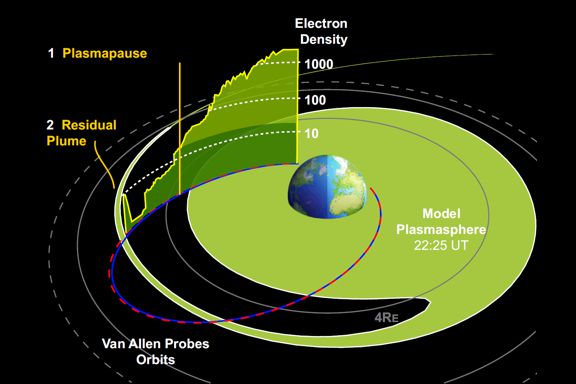
This chapter considers the future of wide-field, plasmaspheric extreme ultraviolet (EUV) imaging, including reviews of previous work as well as some new material. We begin with a review of the technological and scientific progress made by the EUV imager that operated onboard the Imager for Magnetopause-to-Aurora Global Exploration (IMAGE) spacecraft from 2000 to 2005. Analysis of the future of plasmaspheric EUV imaging is organized into three major topics. The first major topic is 30.4 nm imaging of terrestrial He+ ions. We consider two improved 30.4 nm camera designs, and their use to study important science topics such as fine-scale structure, erosion, and refilling. We analyze the benefits of three notional mission designs: continuous and/or stereo imaging from a high-inclination circular orbit, side-view imaging from geosynchronous orbit, and side-view imaging from the Moon. The second major topic is 83.4 nm imaging of terrestrial O+ and O++ ions. We review the use of EUV imaging to provide much-needed system-level measurements of the dense oxygen torus—whose origin and global distribution remain unknown after decades of in situ observations. Simulated 83.4 nm images demonstrate the scientific value of macroscale information about the oxygen torus. The third major topic is near-68 nm EUV imaging of the S++ ions in the Io plasma torus around the planet Jupiter. We review the Io torus's central role in driving convection in the Jovian magnetosphere, and the need for imaging to capture fundamental elements of this process. To achieve Io torus imaging we introduce a new EUV camera identical to IMAGE EUV except for a new multilayer mirror coating optimized for 68 nm. We present simulated images to illustrate EUV imaging's enormous potential to explore, observe, and understand the Io plasma torus.
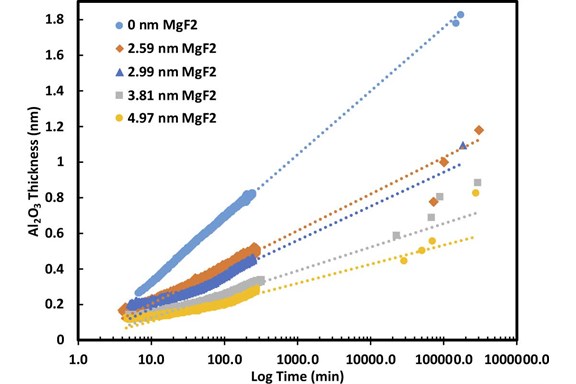
To maintain high, broad-band reflectance, thin transparent fluoride layers, such as MgF2, are used to protect aluminum mirrors against oxidation. In this study, we present, for the first time, combined X-ray photoelectron spectroscopy (XPS) and spectroscopic ellipsometric (SE) studies of aluminum oxidation as a function of MgF2 overlayer thickness (thickness 0-5 nm). Dynamic SE tracks the extent of oxide growth every ca. 2s over a period of several hours after the evaporated Al + MgF2 bilayer is removed from the deposition chamber. Aluminum oxidation changes under the fluoride layer were quantitatively verified with XPS. Changes in chemical state from Al metal to Al oxide were directly observed. Oxide growth is computed from relative XPS peak areas as corrected for electron attenuation through the MgF2 overlayer. An empirical formula fits time-dependent data for aluminum surfaces protected by MgF2 as a function of MgF2 layer thickness: aluminum-oxide thickness = kSE*log(t)+bSE. The slope depends only on MgF2 thickness, decreasing monotonically with increasing MgF2 thickness. This method of employing SE coupled with XPS can be extendable to the study of other metal/overlayer combinations.
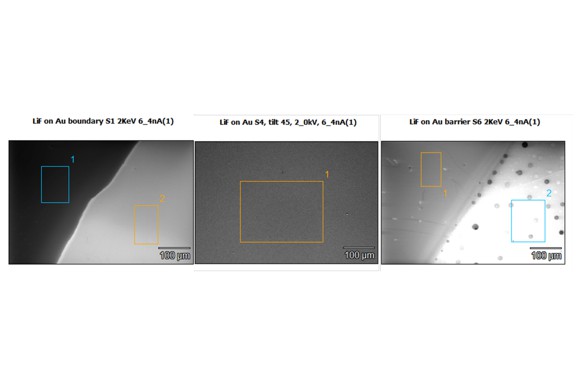
Lithium fluoride (LiF) is difficult to work with because of its hygroscopic nature (it pulls water out of air). The stability limits of LiF thin films and the nature of their failure when exposed to humid air are poorly understood. We show that LiF films undergo irreversible changes in optical properties and microstructure as determined by ellipsometry and SEM when exposed to dew points greater than 6 C. On the other hand, samples stored at a dew point of -22 C (4% RH at room temperature), showed only small changes in ellipsometric parameters. The ones stored at intermediate humidity 6 C (21% RH at room temperature) showed larger changes in ellipsometric parameters. SEM shows that deliquescence as well as efflorescence is important in LiF thin films. In situ spectroscopic ellipsometric measurements using a controlled variable humidity environment illuminates the changes in LiF thin films moving from moisture absorption to complete deliquescence.
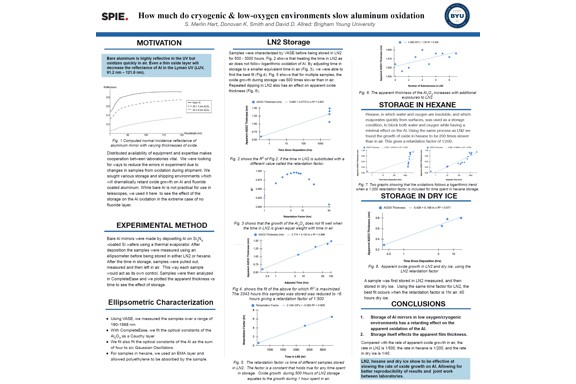
Aluminum is the best choice of material for broadband mirrors. However, once an oxide layer forms on the surface of the mirrors the reflectance in the far ultraviolet range decreases. The study of Al mirrors is difficult because they oxidize so quickly in the air. This makes reproducibility and joint work between laboratories difficult because the mirrors will oxidize and make successive measurements inaccurate. We have found that storing aluminum thin-film mirrors in low oxygen environments (such as liquid nitrogen, dry ice, and hexane) retards mirror oxidation. We examined the retardation of the growth of aluminum oxide during storage in these environments. This oxidation retardation was most pronounced when mirrors were stored in liquid nitrogen. In comparing the growth rate of oxide out of storage to that while it was in storage, we found that the apparent growth of aluminum oxide, is 1/500 in liquid nitrogen, 1/200 in hexane and 1/40 in dry ice.
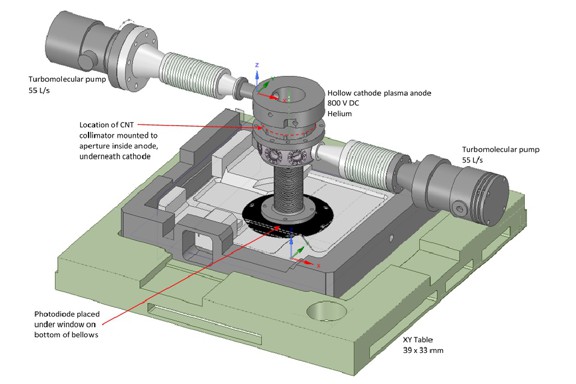
We report on a large-area, high-aspect-ratio, carbon nanotube (CNT) forest structure produced at BYU acting as a window/separator for a hollow cathode EUV lamp. The structure has large-surface-area, high light trans-mission, and differential pumping. CNT fabrication allows for variable dimensions, which allows various EUV distributions and pressure gradients to be possible. Theory is presented for predicting such distributions and gradients. Several structures have been fabricated; their dimensions, properties, and predicted distributions and gradients are given.
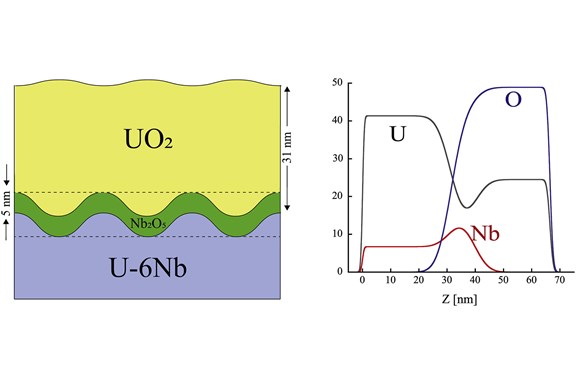
U-6Nb is a uranium alloy containing 6 wt% niobium that possesses high corrosion resistance. The structure and composition of the passivating oxide layer formed on air-aged U-6Nb, which gives the material its corrosion resistant properties, was characterized using surface scattering techniques. Stable oxide layers formed on the surface of a set of U-6Nb alloy thin films under ambient conditions were investigated using neutron reflectometry (NR), x-ray reflectometry (XRR) and grazing incidence x-ray diffraction (GIXD). The passivating oxide was composed of approximately 27% U, 5% Nb, and 68% O, primarily consisting of a thin niobium oxide layer (5.5 ± 0.4 nm) separating a thicker UO2 layer (27.1 ± 2.3 nm) from the underlying U-6Nb alloy. A critical density of enriched niobium oxide at the metal-oxide interface is hypothesized to limit oxygen diffusion and confer high corrosion resistance to the alloy.
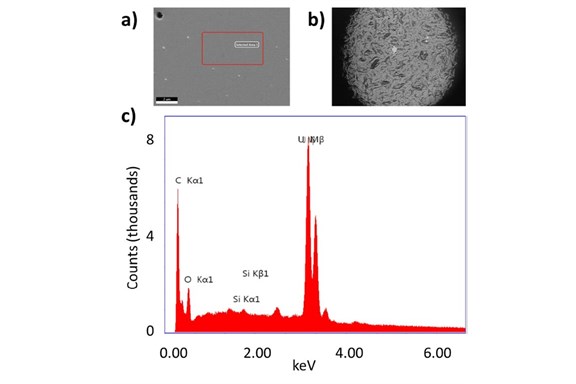
Uranium and thorium oxides have critical roles as fuels in existing nuclear power plants, as well as in proposed reactor concepts. The thermal conductivity of these materials determines their ability to transfer heat from the reactor core to the surrounding coolant. Additionally, these actinide compounds are of interest in condensed matter physics because of the 5f orbitals and unique electron interaction, coupling, and scattering events that can occur. Because of the radioactivity of thorium and uranium, thin film measurements of actinide materials are used to limit the amount of operator exposure, but standard thermal characterization methods are not well suited for thin films. This paper presents the process of depositing thin film UOx and ThOx samples of nm-μm thicknesses and the results of thermal property measurements. Thin films were deposited on silicon and glass substrates via dc-magnetron sputtering using an argon/oxygen mixture as the working gas. The thermal properties of the films were measured by the Thermal Conductivity Microscope (TCM). This uses one laser to generate thermal waves and a second laser to measure the magnitude and phases of the thermal waves to obtain the conductivity of materials. The results of the research show that the UOx film properties are lower than bulk values and that the role of the substrate has a considerable effect on determining the measured properties. Future work aims at improving the deposition process. Epitaxial film growth is planned. Additional understanding of thermal property measurements is targeted.
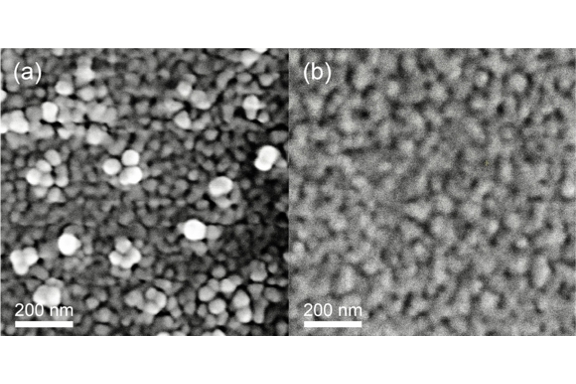
We have used spectroscopic ellipsometry to measure the optical constants of evaporated amorphous zinc arsenide (Zn3As2). A five parameter model using a Tauc-Lorentz oscillator was found to fit well each of six amorphous samples deposited on Si3N4/silicon, allowing the layer thicknesses and optical constants to be deduced. Layer thicknesses varied from 20 to 70 nm. The fitted value of the optical gap (Tauc gap) is 0.95 eV, close to the 1.0 eV band gap for crystalline bulk zinc arsenide. A single set of parameters from an ensemble Tauc-Lorentz model can be used to determine the thicknesses of amorphous Zn3As2 layers as long as the layers are \&\#x2273; 25 nm thick. Measured film thicknesses do not correlate with targeted thicknesses, likely due to low sticking coefficients of evaporated zinc arsenide.
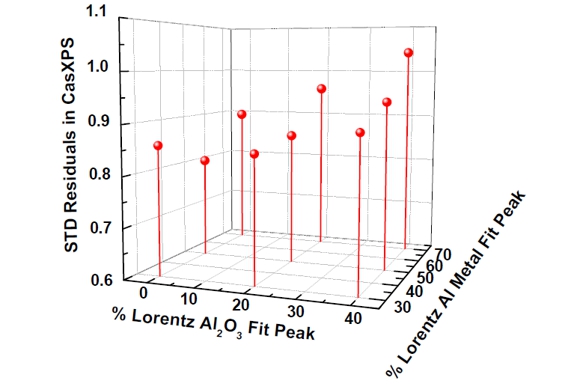
To maintain high, broad-band reflectance, thin transparent fluoride layers, such as MgF2, are used to protect the of aluminum mirrors against oxidation since aluminum oxide absorbs short wavelength light. In this study, we present, for the first time, combined X-ray photoelectron spectroscopy (XPS) and ellipsometric (SE) studies of aluminum oxidation as a function of MgF2 over a range of layer thickness (0-6 nm). We also show for the first time, dynamic SE data which, with appropriate modeling, tracks the extent of oxide growth every few seconds over a period of several hours after the evaporated Al + MgF2 bilayer is removed from the deposition chamber, exposing it to the air. For each SE data set, because the optical constants of ultrathin metals films depend strongly on deposition conditions and their thickness, the optical constants for Al, as well as the Al and Al2O3 thicknesses, were fit. SE trends were confirmed by X-ray photoelectron spectroscopy. There is a chemical shift in the Al 2s electron emission peak toward higher binding energy as the metal oxidizes to Al+3. The extent of oxide growth can be modeled from the relative area of each peak once they are corrected for the attenuation through MgF2 layer. This generates an empirical formula: oxide thickness= k*log(t) +b, for the time-dependent aluminum-oxide thickness on aluminum surfaces protected by MgF2 as a function of MgF2 layer thickness. Here, k is a factor which depends only on MgF2 thickness, and decreases with increasing MgF2 thickness. The techniques developed can illuminate other protected mirror systems.
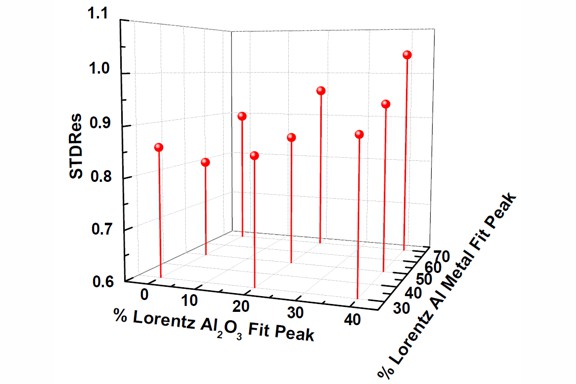
Aluminum enjoys broad band reflectivity and is widely used as an astronomical reflector. However, it oxides rapidly, and this oxide absorbs very short wavelength light, which limits the performance of aluminum mirrors. Accordingly, thin transparent layers, such as films of MgF2, are used to protect aluminum. In this study, we present an X-ray photoelectron pectroscopy (XPS) study of the chemical changes in MgF2 - protected aluminum that take place as it oxidizes (is exposed to the air). XPS reveals the rate of Al oxidation for different MgF2 thicknesses as determined from measurements obtained from 5 min to 8 months of air exposure. The degree of Al oxidation depends on the MgF2 over layer thickness.
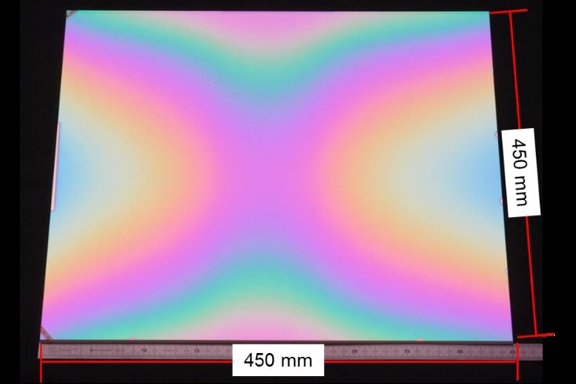
While no solid barrier layer is transparent below ~103nm, simulations show that ~9.5nm LiF on 8.5nm MgF2 on Al could reflect some hydrogen Lyman lines better than a single fluoride layer does. Experiments are promising.

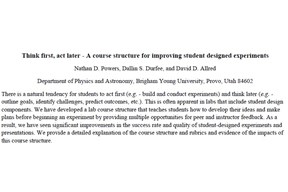

We report on the results of computationally designing and optimizing
multilayer mirrors for broadband reflectivity in a region spanning from
the vacuum ultraviolet to the infrared. Such a mirror would open up
new possibilities for future space observatories. Because of the
immense number of possible layer combinations and thicknesses for a
multilayer mirror, we automated the mirror selection process with a
genetic algorithm. Starting with a random object population within the
simulation, a genetic algorithm iteratively selects and mutates the best
portion of a population of objects that fit given design criteria to create
a new population; this can be repeated as many times as desired. Our
genetic algorithm yielded a high broadband reflectance mirror, which
was then optimized via gradient search within the program. We found
that placing a few layers under an aluminum coating can significantly
increase extreme ultraviolet reflectivity, which would give access to
important spectral lines such as that of the dominant He-II transition.
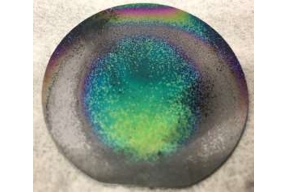
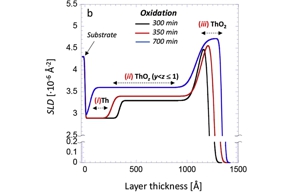
Oxidation of a ∼1000 Å sputter-deposited thorium thin film at 150 °C in 100 ppm of flowing oxygen in argon produces the long-sought solid form of thorium monoxide. Changes in the scattering length density (SLD) distribution in the film over the 700-min experiment measured by in-situ, dynamic neutron reflectometry (NR) shows the densities, compositions and thickness of the various thorium oxides layers formed. Screened, hybrid density-functional theory calculations of potential thorium oxides aid interpretation, providing atomic-level picture and energetics for understanding oxygen migration. NR provided evidence of the formation of substoichiometric thorium oxide, ThOy (y < 1) at the interface between the unreacted thorium metal and its dioxide overcoat which grows inward, consuming the thorium at a rate of 2.1 Å/min while y increases until reaching 1:1 oxygen-to-thorium. Its presence indicates that kinetically-favored solid-phase ThO can be preferentially generated as a majority phase under the thermodynamically-favored ThO2 top layer at conditions close to ambient.
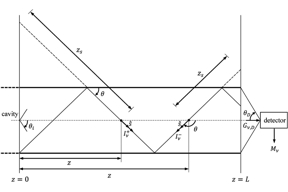
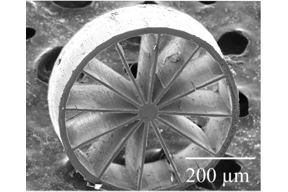

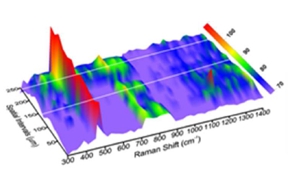
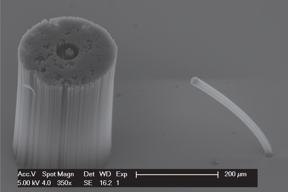
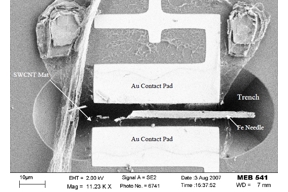

We measured the transmittance and reflectance of two reactively sputtered diodes prepared with approximately 20 nm of UOx in the extreme ultraviolet (XUV) at the Advanced Light Source at Lawrence Berkeley National Laboratory. Fitting the reflectance data to the Parratt model yielded the thickness of the UOx film. This thickness combined with a simple analysis of the transmission measurements provides estimates for the imaginary part of the index of refraction for UOx at approximately every tenth of a nanometer from about 3 nm to 30 nm with emphasis in the 12- to 13-nm range. The analysis discussed in this paper yields only the imaginary part of the complex index but will lead to a more robust analysis to find both the real and imaginary parts of the index of refraction. These values provide researchers with information for modeling, design, and fabrication of optical systems in the extreme ultraviolet.
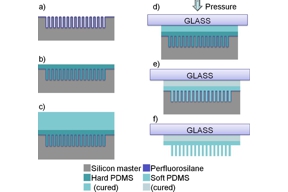
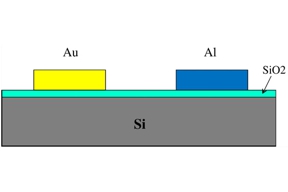

We use a laser high-harmonics-based extreme-ultraviolet (EUV) polarimeter to determine the optical constants of elemental uranium in the wavelength range from 10 to 47 nm. The constants are extracted from the measured ratio of p-polarized to s-polarized reflectance from a thin uranium film deposited in situ. The film thickness is inferred from a spectroscopic ellipsometry measurement of the sample after complete oxidation in room air. Uranium has been used as a high-reflectance material in the EUV. However, difficulties with oxidation prevented its careful characterization previous to this study. We find that measured optical constants for uranium vary significantly from previous estimates. (C) 2010 Optical Society of America
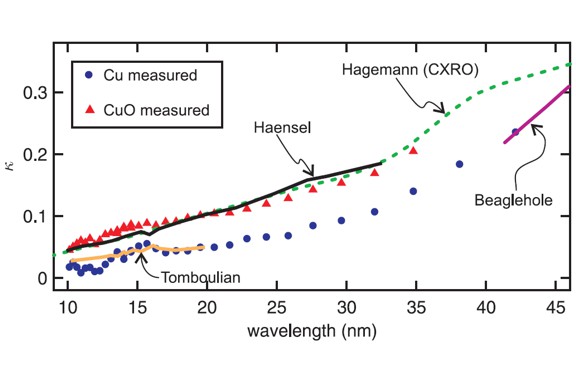
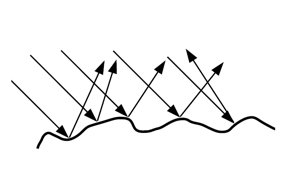
Optics in the extreme ultraviolet (XUV) have important applications in microelectronics, microscopy, space physics, and in imaging plasmas. Because of the short wavelengths involved in these applications, it is critical to account for interfacial roughness to accurately predict the reflection and absorption of XUV optics. This paper examines two possible effects of roughness on optical absorption, non-specular reflection and enhanced transmission and compares these to measured experimental data on a rough Y2O3 thin film.
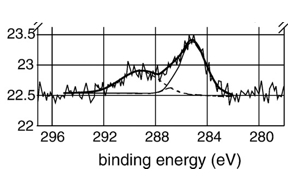
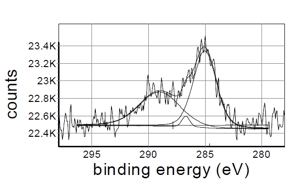

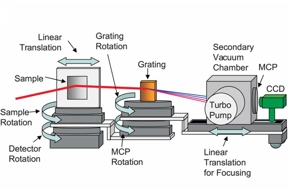
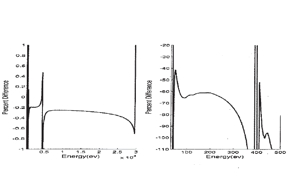
Whereas the real part of the refractive index is dependent on both transmittance and reflectance, the imaginary part can be determined from transmittance data alone. It is possible to use Kramers-Kronig analysis to calculate the real part if the imaginary part is known over a sufficiently broad range. We show that the delta calculated from reflection and transmission data without taking into account roughness may underestimate the real part of the refractive index of the scandium oxide samples we are studying by up to 40% near 270 eV.
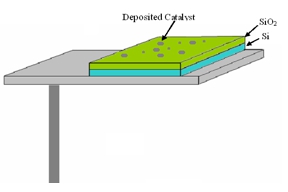
We report on the iron-catalyzed, CVD growth of carbon nanotubes on a variety of substrates and their subsequent analysis. We discuss the use of “indirect evaporation” to prepare the required iron catalyst. The optimum temperature for growth of nanotubes mats was between 925 and 950 degrees C. These were shown by transmission electron microscopy to contain single-walled carbon nanotubes (SWCNTs). We examined the results of the deposition in scanning electron microscopy and saw what appeared to be bright spots randomly arrayed along the carbon nanotube fibers. We termed this pattern ‘beads on a string’. We present evidence that the bright features are not associated with the nanotubes directly but are iron/carbon clusters that happen to lie on the surface of the substrate near where the tubes fell during or after deposition. We have shown that the deposition procedure is fairly robust and growth results have been reproduced using Goddard Space Flight Center (GSFC)-deposited catalyst and CVD facilities at Brigham Young University (BYU).
